A Framework to Analyze the Requirements of a Multiport Megawatt-Level Charging Station for Heavy-Duty Electric Vehicles
Abstract
:1. Introduction
- 1.
- We use extant HD vehicle telemetry data in a maximal covering location problem formulation [16] to identify optimal charging station placement within a geographical boundary.
- 2.
- We use vehicle schedules from these optimally placed stations to generate input data for a high-fidelity agent-based station model that can simulate the charging and queuing behavior of EVs at the station.
- 3.
- We run parametric studies using Monte Carlo simulations to develop valuable insights on station design, station utilization, and station loads.
2. MW-Scale Charging Station Model
3. Framework for Station Design Requirement Analysis
3.1. Vehicle Traffic Behavior Data Analysis
3.1.1. Telemetry Data
3.1.2. An Optimal Network of En-Route MW-Scale Chargers
3.1.3. Opportunity Charging
3.1.4. Linear Programming Formulation
3.1.5. Simulation of Station Demand
3.2. Parametric Study Using Charging Station Model
3.2.1. Vehicle Mix and Charge Acceptance Curves
- Out of all the vehicles charging only at 1.2 MW ports, 68.76% are 600 kWh and 31.24% are 1200 kWh battery pack vehicles.
- Out of all the vehicle charging at combinations of 100 kW and 1.2 MW ports, 10.48% are 600 kWh vehicles charging at 100 kW ports, 10.42% are 1200 kWh vehicles charging at 100 kW ports, 58.28% are 600 kWh vehicles charging at 1.2 MW ports, and 20.82% are 1200 kWh vehicles charging at 1.2 MW ports.
3.3. Parametric Variations
- Vehicle traffic over the optimized set of MW-scale stations ranges from 2 to 100 vehicles per day. This range is discretized with a finer step at the lower end than the higher end since stations with very high traffic are relatively lower. Accordingly, the traffic conditions investigated were: 2, 5, 10, 15, 30, 60, and 100 vehicles per day.
- We investigated two station configurations:
- (i)
- Stations with only 1.2 MW charging ports, with port counts of 1, 3, 5, and 7.
- (ii)
- Stations with both 1.2 MW and 100 kW charging ports, with port counts of (“x” number of 1.2 MW + “y” number of 100 kW) 1+1, 2+2, 5+5, and 6+10. The variation in port count is such that the minimum and maximum number of ports can adequately charge the minimum and maximum vehicle traffic, respectively, with the least amount of wait time.
4. Results and Discussions
4.1. Impact on Station Throughput
- In general, the average charging time is dependent on the mix of vehicle traffic (i.e., proportion of vehicles with different battery sizes), not the volume of traffic (i.e., total number of vehicles) or the availability of infrastructure such as the number of charging ports.
- The wait time is directly dependent on traffic volume and the availability of charging ports (thus infrastructure capacity).
4.2. Impact on Station Power Demand
- The average power demand, station energy demand, and peak power of the station are dependent on the traffic volume and the utilization of the installed ports.
- An increase in average demanded power with an increased number of ports becomes more apparent as vehicle traffic increases.
- Understanding the traffic pattern seen by the station is critical to properly design the station infrastructure.
4.3. Geospatial Station Loads
5. Conclusions and Future Work
- 1.
- Vehicle electrification that can be achieved through charging infrastructure deployment depends on driving range and the mix of short/long dwell time charging. Of the investigated vehicle fleet, we calculated the possibility of an 80% electrification with a 125 MW-scale charging station if the electric range was 300 miles and no long dwell time charging was available. If the vehicle range was 600 miles, 50 MW-scale stations would electrify 80% of the fleet. Of course, per-station charging energy demand in the latter case would be higher.
- 2.
- Geographically, the optimal charging station location coincides with higher HD vehicle needs. Within the geographical scope of this study, we found that cities with ports such as Los Angeles and Oakland were identified first as optimal candidates for MW-scale charging stations. Future work can extend this study with a national vehicle telemetry database.
- 3.
- Consideration of grid capacity while identifying the optimal station charging location was out of scope for this study and should be considered in a future extension of this work.
- 4.
- Charging power and, hence, time are limited by either the port capacity or the BMS control algorithm, which factors in SOC ranges and temperature. A combination of the CC-CV-based charging protocol rated at 1.5C and 1.2 MW ports yielded charging times in the range of 35–40 min in this study. To achieve parity between charging time and conventional HD vehicle refueling time, both port capacity and BMS rating need to increase.
- 5.
- Parametric studies such as this can complement economic analysis needed for station design. For example, we found that at 100 vehicles per day, installing seven 1.2 MW ports instead of five will result in feasible wait times as the station. A future economic analysis can then estimate break-even points for capital expenditures involved in designing such a station, knowing very well that a five-port station would provide unacceptable QoS and, hence, should not be a station candidate.
- 6.
- While we examined a public charging setup in this current work–meaning vehicles are charged on a first-come, first-served basis—the implementation of coordinated charging can help reduce demand charges or shift peak power by using available DER. Specifically, long dwell time vehicles charging at low-power ports can be good candidates for controllable loads, and future research is needed in this direction.
Author Contributions
Funding
Institutional Review Board Statement
Informed Consent Statement
Acknowledgments
Conflicts of Interest
Abbreviations
| BMS | Battery management system |
| CC-CP | Constant current constant power |
| CC-CV | Constant current constant voltage |
| DER | Distributed energy resources |
| EV | Electric vehicle |
| EVI-EnSite | Electric Vehicle Infrastructure, Energy Estimation, and Site Optimization tool |
| HD | Heavy-duty |
| kW | Kilowatt |
| kWh | Kilowatt hour |
| LD | Light-duty |
| MCC | Multistage constant current |
| MD | Medium-duty |
| MW | Megawatt |
| MWh | Megawatt-hour |
| NMC | Lithium nickel manganese cobalt Oxide |
| NREL | National Renewable Energy Laboratory |
| QoS | Quality of service |
| SOC | State of charge |
| VCP | Variable current profile |
| VMT | Vehicle miles traveled |
References
- Frost & Sullivan. Global Commercial Vehicle Electrification Potential and Trends, Forecast to 2025; Technical Report Report ID 4663547; Research and Markets: Dublin, Ireland, 2018. [Google Scholar]
- California Air Resources Board. California Takes Bold Step to Reduce Truck Pollution. 2020. Available online: ww2.arb.ca.gov/news/california-takes-bold-step-reduce-truck-pollution (accessed on 1 June 2021).
- Gao, Z.; Lin, Z.; Franzese, O. Energy consumption and cost savings of truck electrification for heavy-duty vehicle applications. Transp. Res. Rec. J. Transp. Res. Board 2017, 2628, 99–109. [Google Scholar] [CrossRef]
- Kisacikoglu, M.C.; Bedir, A.; Ozpineci, B.; Tolbert, L.M. PHEV-EV Charger Technology Assessment with an Emphasis on V2G Operation; Technical Report ORNL/TM-2010/221; Oak Ridge National Laboratory: Oak Ridge, TN, USA, 2012. [Google Scholar]
- Alexander, M.; Crisostomo, N.; Krell, W.; Lu, J.; Ramesh, R. Assembly Bill 2127 Electric Vehicle Charging Infrastructure Assessment: Analyzing Charging Needs to Support Zero-Emission Vehicles in 2030—Revised Staff Report; Technical Report Publication Number: CEC-600-2021-001-REV; California Energy Commission: Sacramento, CA, USA, 2021. [Google Scholar]
- Federal Motor Carrier Safety Administration, United States Department of Transportation. Summary of Hours of Service Regulations. Available online: https://www.fmcsa.dot.gov/regulations/hours-service/summary-hours-service-regulations (accessed on 1 November 2020).
- Tan, L.; Wu, B.; Yaramasu, V.; Rivera, S.; Guo, X. Effective Voltage Balance Control for Bipolar-DC-Bus-Fed EV Charging Station With Three-Level DC–DC Fast Charger. IEEE Trans. Ind. Electron. 2016, 63, 4031–4041. [Google Scholar] [CrossRef]
- Nair, A.C.; Fernandes, B.G. A Solid State Transformer based Fast Charging Station for all Categories of Electric Vehicles. In Proceedings of the IECON 2018—44th Annual Conference of the IEEE Industrial Electronics Society, Washington, DC, USA, 21–23 October 2018; pp. 1989–1994. [Google Scholar]
- Sadeghi-Barzani, P.; Rajabi-Ghahnavieh, A.; Kazemi-Karegar, H. Optimal fast charging station placing and sizing. Appl. Energy 2014, 125, 289–299. [Google Scholar] [CrossRef]
- Wu, F.; Sioshansi, R. A stochastic flow-capturing model to optimize the location of fast-charging stations with uncertain electric vehicle flows. Transp. Res. Part D Transp. Environ. 2017, 53, 354–376. [Google Scholar] [CrossRef]
- Wagner, S.; Götzinger, M.; Neumann, D. Optimal Location of Charging Stations in Smart Cities: A Point of Interest Based Approach. In Proceedings of the Thirty Fourth International Conference on Information Systems, Milan, Italy, 15–18 December 2013. [Google Scholar]
- Gnann, T.; Funke, S.; Jakobsson, N.; Plötz, P.; Sprei, F.; Bennehag, A. Fast charging infrastructure for electric vehicles: Today’s situation and future needs. Transp. Res. Part D Transp. Environ. 2018, 62, 314–329. [Google Scholar] [CrossRef]
- Morrissey, P.; Weldon, P.; O’Mahony, M. Future standard and fast charging infrastructure planning: An analysis of electric vehicle charging behaviour. Energy Policy 2016, 89, 257–270. [Google Scholar] [CrossRef]
- Zenginis, I.; Vardakas, J.S.; Zorba, N.; Verikoukis, C.V. Analysis and quality of service evaluation of a fast charging station for electric vehicles. Energy 2016, 112, 669–678. [Google Scholar] [CrossRef]
- Pelletier, S.; Jabali, O.; Laporte, G. Charge scheduling for electric freight vehicles. Transp. Res. Part B Methodol. 2018, 115, 246–269. [Google Scholar] [CrossRef]
- Berman, O.; Krass, D. The generalized maximal covering location problem. Comput. Oper. Res. 2002, 29, 563–581. [Google Scholar] [CrossRef]
- Ucer, E.Y.; Kisacikoglu, M.C.; Erden, F.; Meintz, A.L.; Rames, C.L. Development of a DC Fast Charging Station Model for Use with EV Infrastructure Projection Tool. In Proceedings of the 2018 IEEE Transportation Electrification Conference and Expo (ITEC), Long Beach, CA, USA, 13–15 June 2018. [Google Scholar]
- National Renewable Energy Laboratory. EVI-EnSite: Electric Vehicle Infrastructure—Energy Estimation and Site Optimization Tool. Available online: https://www.nrel.gov/transportation/evi-ensite.html (accessed on 30 April 2021).
- Burnham, A.; Dufek, E.J.; Stephens, T.; Francfort, J.; Michelbacher, C.; Carlson, R.B.; Tanim, T.R. Enabling fast charging—Infrastructure and economic considerations. J. Power Sources 2017, 367, 237–249. [Google Scholar] [CrossRef]
- Lammert, M.P.; Bugbee, B.; Hou, Y.; Mack, A.; Muratori, M.; Holden, J.; Duran, A.; Swaney, E. Exploring Telematics Big Data for Truck Platooning Opportunities. In WCX World Congress Experience; SAE International: Detroit, MI, USA, 2018. [Google Scholar]
- Karich, P.; Schröder, S. Graphhopper. 2014, Volume 4, p. 15. Available online: http://www.graphhopper.com (accessed on 2 April 2021).
- Muratori, M.; Bush, B.; Hunter, C.; Melaina, M.W. Modeling Hydrogen Refueling Infrastructure to Support Passenger Vehicles. Energies 2018, 11, 1171. [Google Scholar] [CrossRef] [Green Version]
- Gao, Z.; Lin, Z.; Davis, S.C.; Birky, A.K. Quantitative Evaluation of MD/HD Vehicle Electrification using Statistical Data. Transp. Res. Rec. 2018, 2672, 109–121. [Google Scholar] [CrossRef]
- Mareev, I.; Becker, J.; Sauer, D.U. Battery dimensioning and life cycle costs analysis for a heavy-duty truck considering the requirements of long-haul transportation. Energies 2018, 11, 3446. [Google Scholar] [CrossRef] [Green Version]
- Tomaszewska, A.; Chu, Z.; Feng, X.; O’Kane, S.; Liu, X.; Chen, J.; Ji, C.; Endler, E.; Li, R.; Liu, L.; et al. Lithium-ion battery fast charging: A review. ETransportation 2019, 1, 100011. [Google Scholar] [CrossRef]
- Anseán, D.; González, M.; Viera, J.; García, V.; Blanco, C.; Valledor, M. Fast charging technique for high power lithium iron phosphate batteries: A cycle life analysis. J. Power Sources 2013, 239, 9–15. [Google Scholar] [CrossRef]
- Zhang, S.; Xu, K.; Jow, T. Study of the charging process of a LiCoO2-based Li-ion battery. J. Power Sources 2006, 160, 1349–1354. [Google Scholar] [CrossRef]
- Chen, L.; Wu, S.; Shieh, D.; Chen, T. Sinusoidal-Ripple-Current Charging Strategy and Optimal Charging Frequency Study for Li-Ion Batteries. IEEE Trans. Ind. Electron. 2013, 60, 88–97. [Google Scholar] [CrossRef]
- Abdel-Monem, M.; Trad, K.; Omar, N.; Hegazy, O.; Van den Bossche, P.; Van Mierlo, J. Influence analysis of static and dynamic fast-charging current profiles on ageing performance of commercial lithium-ion batteries. Energy 2017, 120, 179–191. [Google Scholar] [CrossRef]
- Chargepoint Express Plus Datasheet. Available online: www.chargepoint.com/files/datasheets/ds-expressplus.pdf (accessed on 24 April 2019).
- CharIN High Power Commercial Vehicle Charging Task Force Aggregated Requirements. 18 February 2019. Available online: www.charinev.org/fileadmin/HPCCV/High_Power_Commercial_Vehicle_Charging_Requirements_v2.0.pdf (accessed on 24 April 2019).
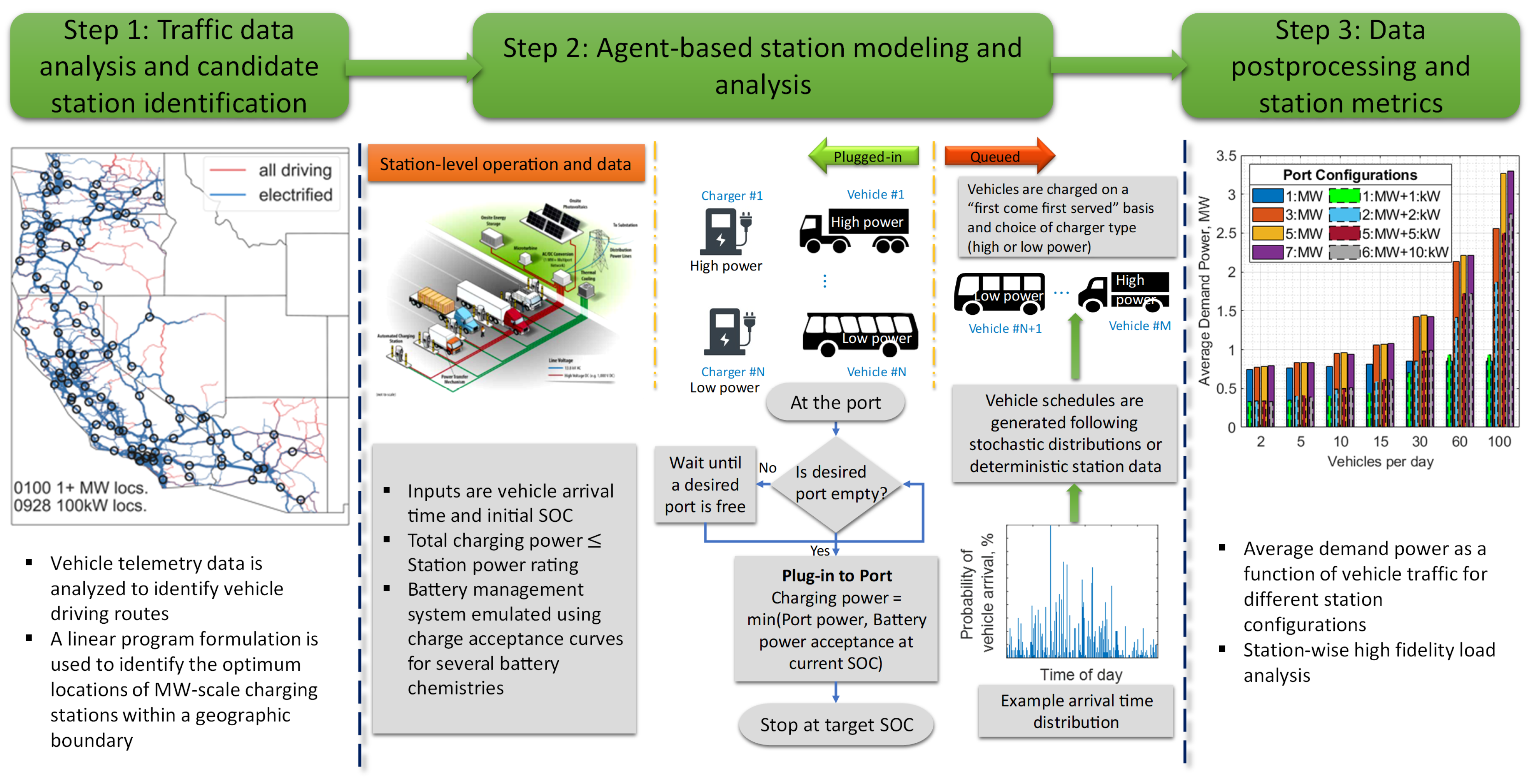
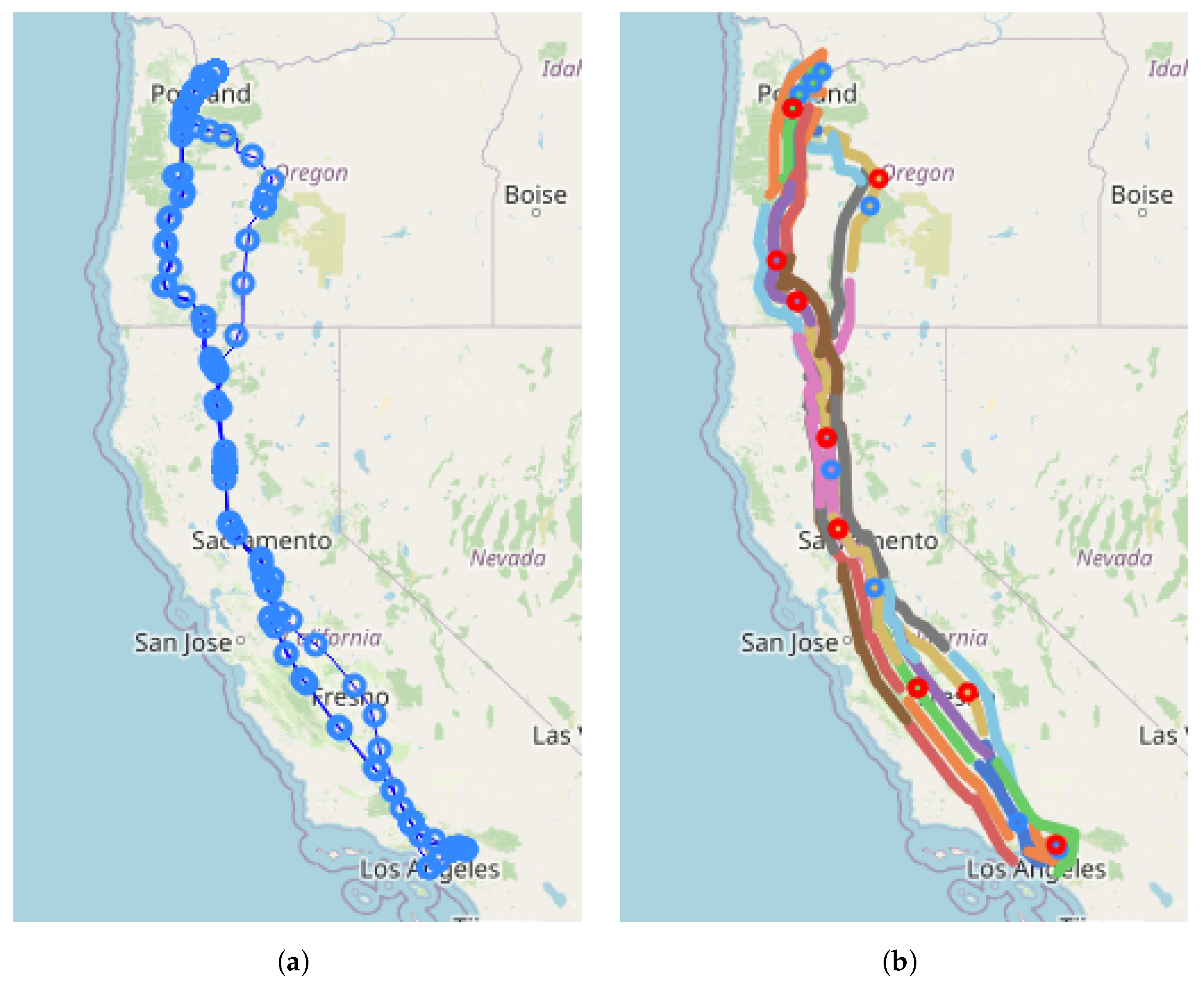


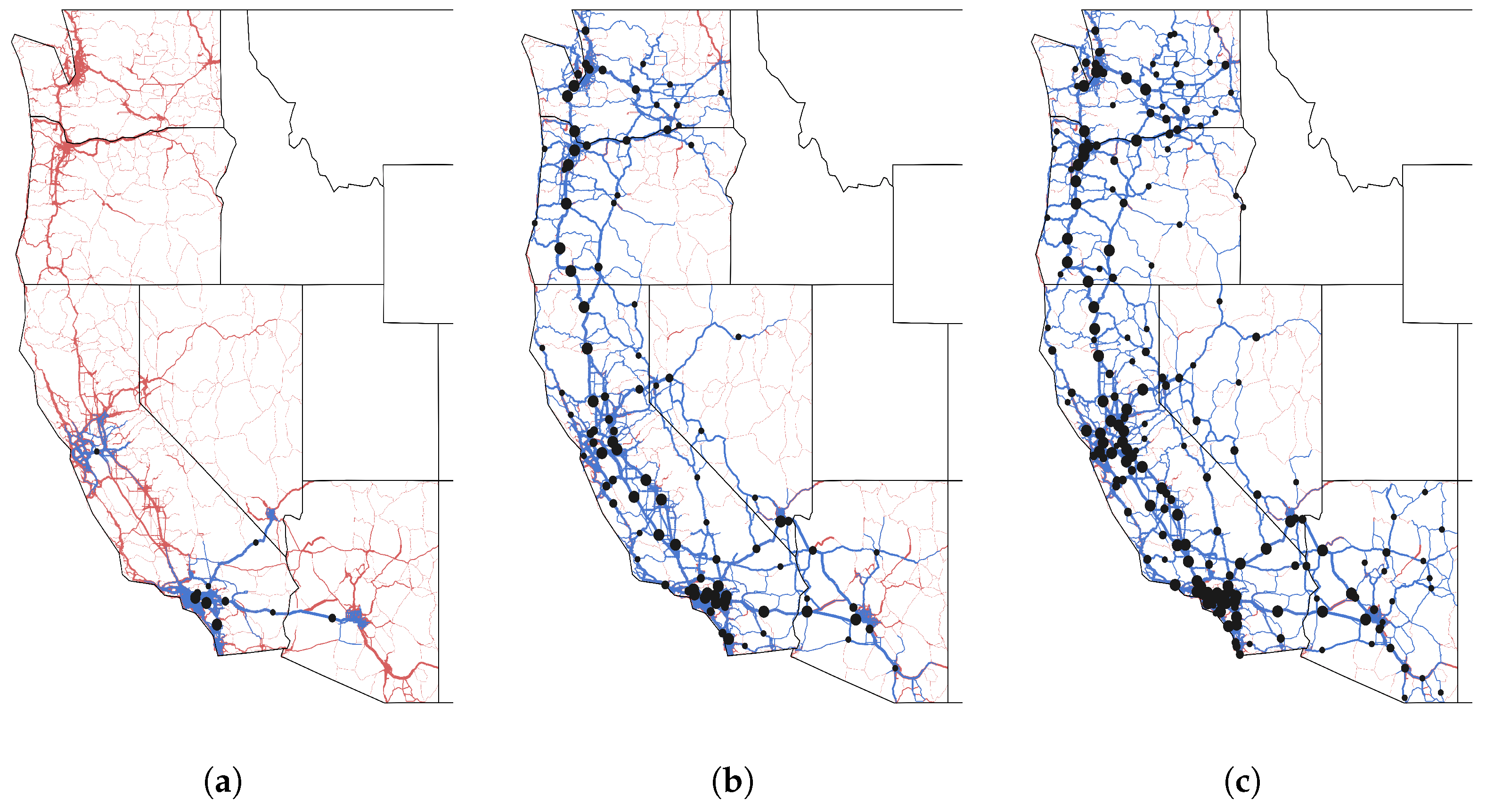
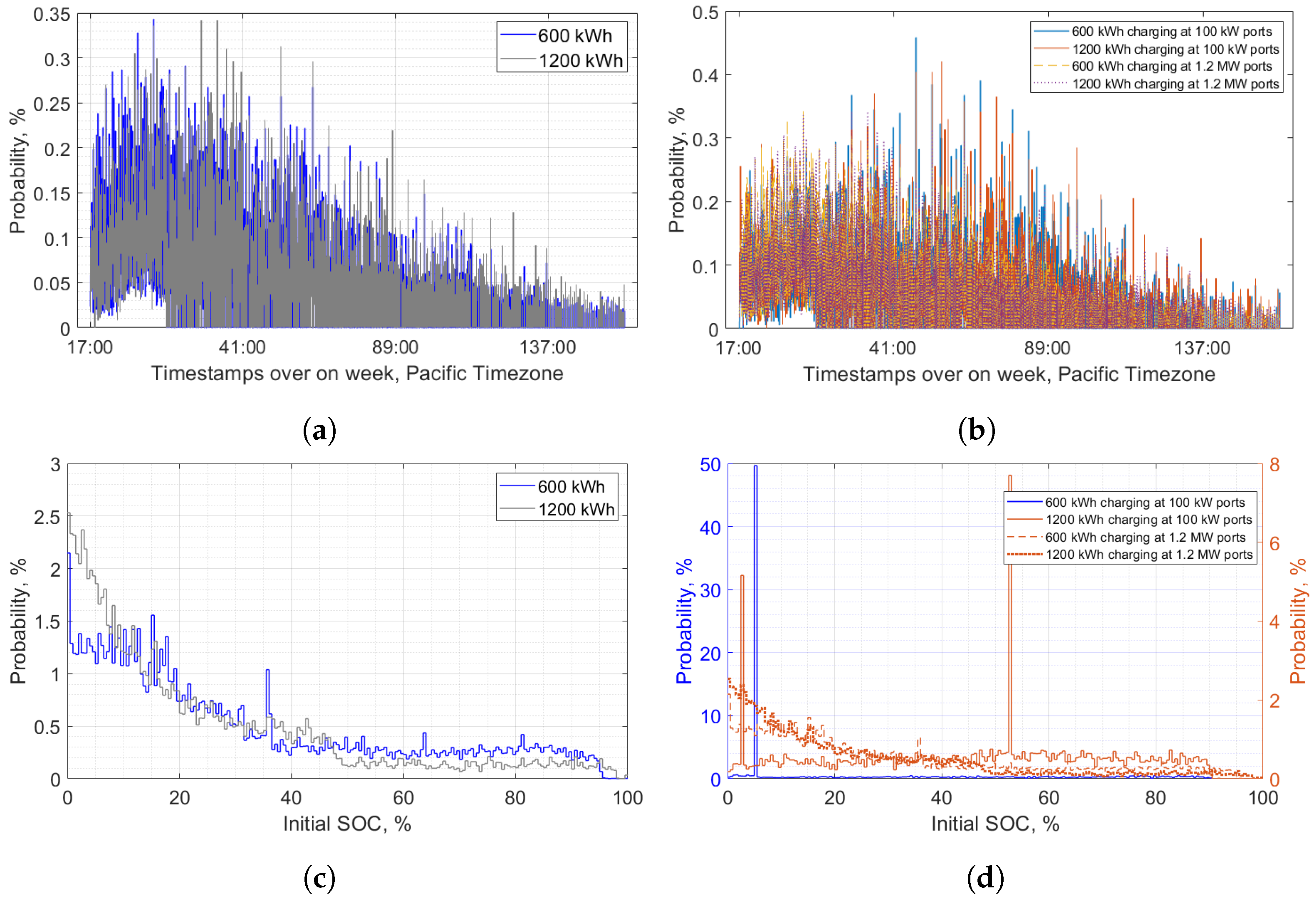
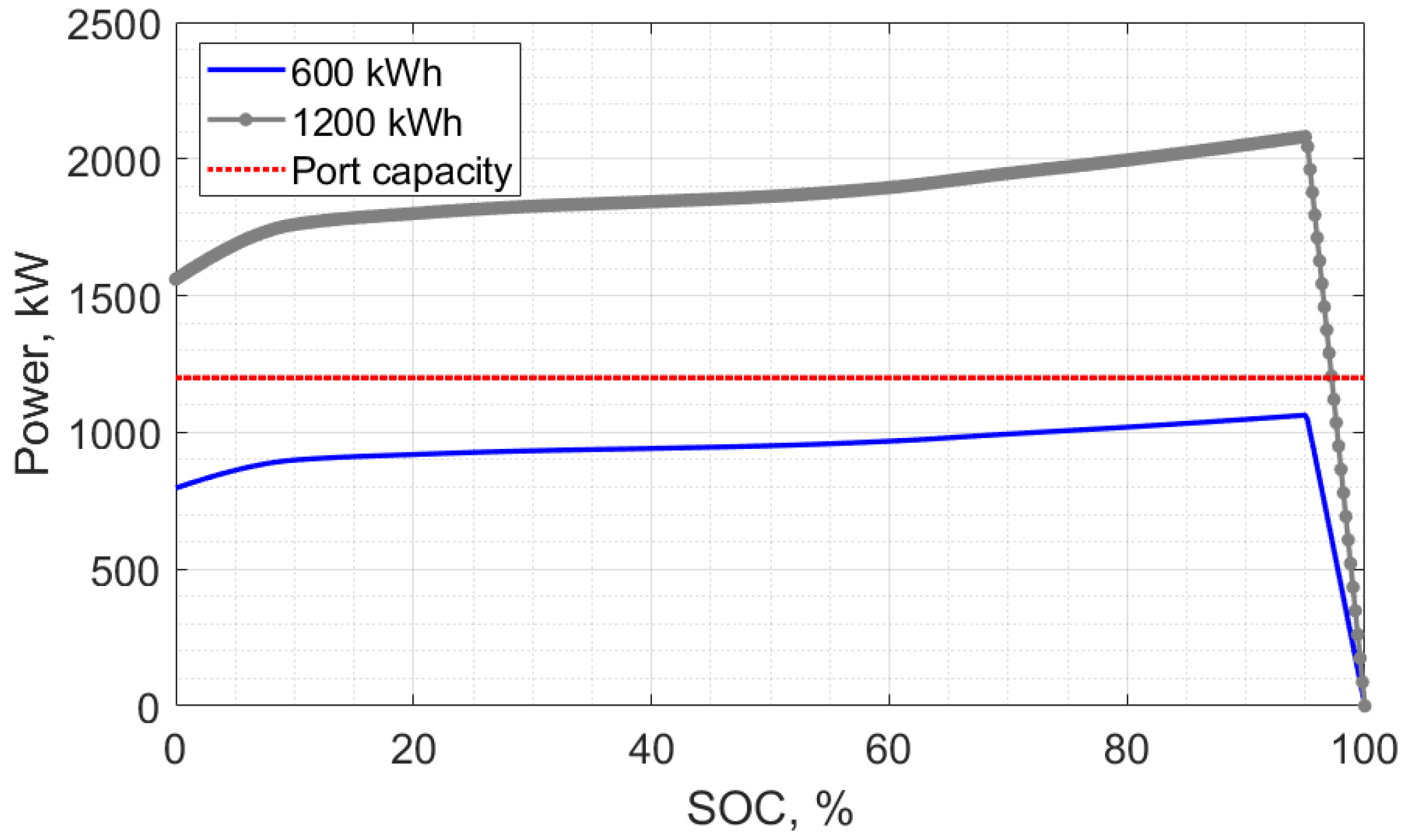
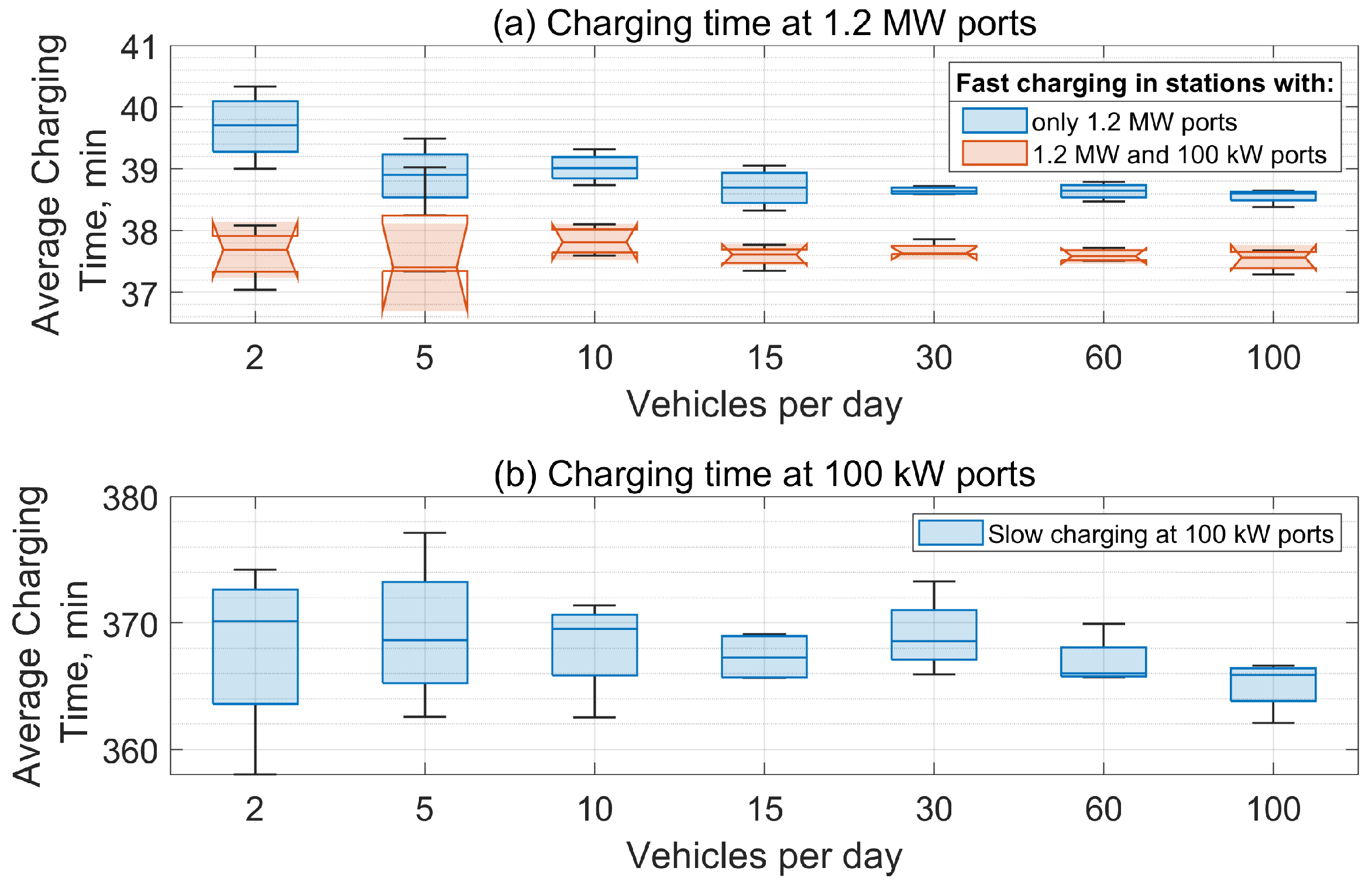

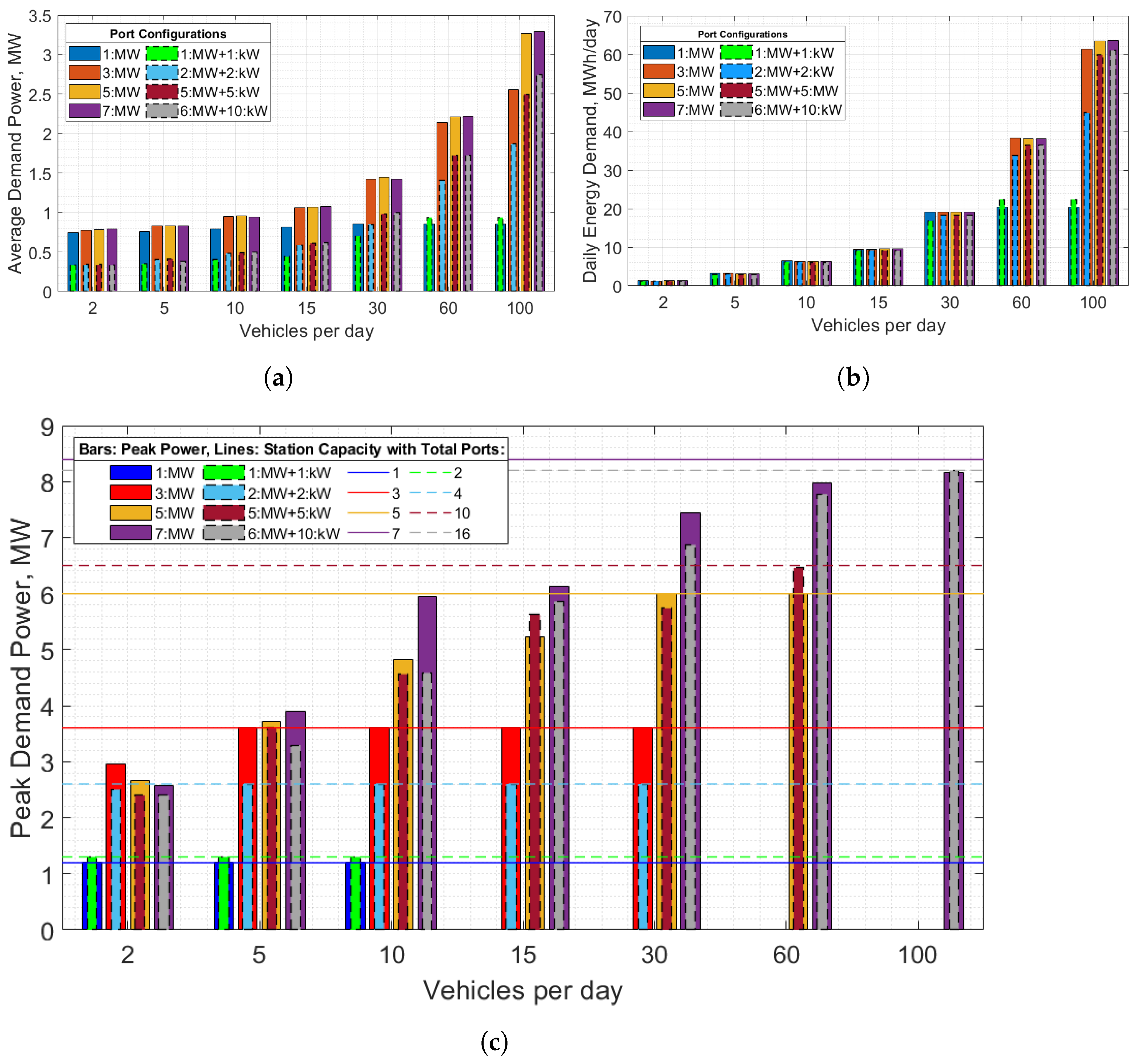

Publisher’s Note: MDPI stays neutral with regard to jurisdictional claims in published maps and institutional affiliations. |
© 2022 by the authors. Licensee MDPI, Basel, Switzerland. This article is an open access article distributed under the terms and conditions of the Creative Commons Attribution (CC BY) license (https://creativecommons.org/licenses/by/4.0/).
Share and Cite
Mishra, P.; Miller, E.; Santhanagopalan, S.; Bennion, K.; Meintz, A. A Framework to Analyze the Requirements of a Multiport Megawatt-Level Charging Station for Heavy-Duty Electric Vehicles. Energies 2022, 15, 3788. https://doi.org/10.3390/en15103788
Mishra P, Miller E, Santhanagopalan S, Bennion K, Meintz A. A Framework to Analyze the Requirements of a Multiport Megawatt-Level Charging Station for Heavy-Duty Electric Vehicles. Energies. 2022; 15(10):3788. https://doi.org/10.3390/en15103788
Chicago/Turabian StyleMishra, Partha, Eric Miller, Shriram Santhanagopalan, Kevin Bennion, and Andrew Meintz. 2022. "A Framework to Analyze the Requirements of a Multiport Megawatt-Level Charging Station for Heavy-Duty Electric Vehicles" Energies 15, no. 10: 3788. https://doi.org/10.3390/en15103788
APA StyleMishra, P., Miller, E., Santhanagopalan, S., Bennion, K., & Meintz, A. (2022). A Framework to Analyze the Requirements of a Multiport Megawatt-Level Charging Station for Heavy-Duty Electric Vehicles. Energies, 15(10), 3788. https://doi.org/10.3390/en15103788





